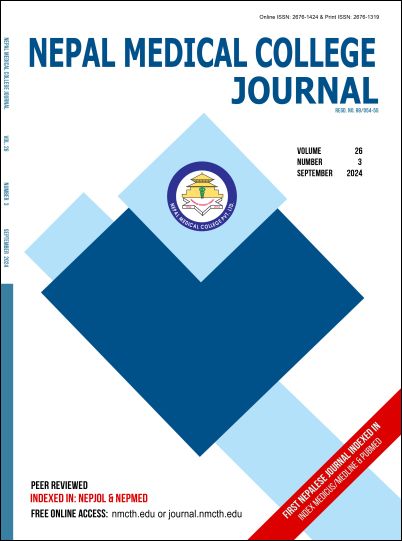Antibiotic Susceptibility Pattern of Pseudomonas aeruginosa and Detection of Virulence Genes in a Tertiary Care Hospital, Kathmandu, Nepal
DOI:
https://doi.org/10.3126/nmcj.v26i3.69878Keywords:
Pseudomonas aeruginosa, antimicrobial resistance, MDR, β-lactamase, virulence genesAbstract
Pseudomonas aeruginosa is one of the most common causes of hospital-acquired infections. It threatens worldwide public health because of its intrinsic antibiotic resistance and virulence. In this context, this research aimed to determine the occurrence of P. aeruginosa in a clinical setting, examine its susceptibility to antibiotics, and detect the presence of virulence genes, viz. exoY, oprL and toxA in all isolates. It was a cross-sectional study carried out from June 2022 to December 2022. A total of 1356 clinical specimens were collected and processed in the laboratory for Gram staining, culture techniques, and biochemical tests. The Kirby-Bauer disk diffusion method was applied to examine the antibiotic susceptibility pattern and conventional PCR was used to detect the virulence genes in all confirmed P. aeruginosa isolates. 40.5% of specimens showed bacterial growth, of which only 3.02% were identified as P. aeruginosa. Among them, 61.0% were multidrug resistant and 29.2% were β-lactamase producers. Aztreonam (70.7%) was the most effective antibiotic. Among all P. aeruginosa isolates, 68.3% isolates were exoY positive, 61.0% were oprL positive and 56.1% were toxA positive. Strategic interventions are required to stop the emergence and spread of antimicrobial resistance as a result of the isolation of multidrug resistant (MDR) isolates carrying these virulence genes. This study can benefit the medical staff and the entire community in building a surveillance system and enhancing infection control procedures.
Downloads
Downloads
Published
How to Cite
Issue
Section
License
Copyright (c) 2024 Nepal Medical College Journal

This work is licensed under a Creative Commons Attribution 4.0 International License.
This license enables reusers to distribute, remix, adapt, and build upon the material in any medium or format, so long as attribution is given to the creator. The license allows for commercial use.




